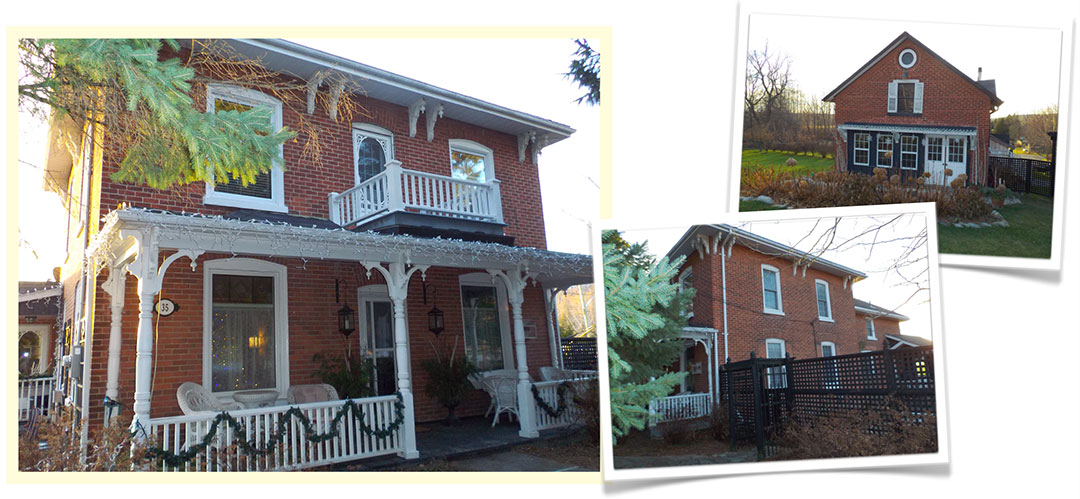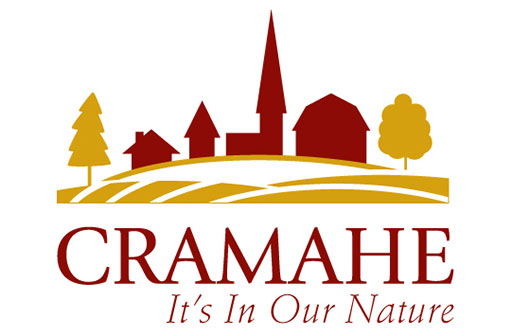35 Percy Street, Colborne
(c.1902-1921)
Roll No. 1411-012-010-15100 – Cramahe Township Ontario

Georgian Vernacular
There is an arcade porch with lovely gingerbread which further enhances the property’s pleasing appearance. It is a well maintained, attractive property, and its back yard falls away, ravine like to the adjacent street, many feet below. The current home owners have terraced the hill to accommodate, trees, plantings and a large and healthy vegetable garden that must be the envy of the neighbourhood.
History or Associative Value
In 1858, Reid plan lots 63/64 were sold to Elizabeth McDonald, wife of innkeeper Sidney McDonald. In 1869, the lots were sold to Albert White Dudley who was described as a “nurseryman” in the 1871 Gazetteer, the earliest mention of fruit growing as an industry in Cramahe, distinct from general farming. In 1877 Daniel Simmons bought the land for $75.00 and sold it in 1882, back to the Dudley’s no less for $1000.00 – a 1300% profit. Best guess at a build date is between 1902 and 1921.
Additional Historical and Genealogical Information
Cramahe Township, Concession 1, Lot 32, Reid Lot 64
Nathaniel Gaffield (ca. 1755-ca. 1838) (LINK) was the first owner of Concession 2, Lot 32, a 200 acre parcel part of which would later become Reid Lot 64. Lot 32 is bounded on the south by King Street West, and on the north by Orchard and Purdy Roads. On the east it is bounded by the undeveloped road allowance running north from Ontario Street. On the west the southern half of the Lot is bounded by Percy Street. Percy Street angles northwestward in the northern half of Lot 32, and the western edge of the lot is along the line Percy would have taken if it had headed straight north.
Although he had probably lived there since at least 1797, Gaffield wasn’t officially granted Lot 32 until 13 May 1804. He sold it to Joseph Keeler (1763-1839) (LINK) on 23 January 1806, but apparently continued to farm there for most of the rest of his life.
Keeler transferred the southern third of Concession 2, Lot 32 to his son Joseph Abbott Keeler (1788-1855) on 1 January 1824. This was the area now bounded by Ontario Street on the west, Percy Street on the east, and King Street on the south. The northern limit was along the backs of the modern properties along the north side of Park Street.
Over the next 30 years Joseph Abbott Keeler sold off bits and pieces of this land to a variety of people. By 1855 he had sold off most of it, and when he died that year what was left was inherited by his son Joseph Keeler III (1824-1881). This Joseph Keeler continued his father’s tradition of selling off sections of the property.
35 Percy Street sits on Reid Lot 64, but the property that now goes with the house also includes Reid Lot 63. Joseph Keeler III sold Reid Lot 63 to Elizabeth McDonald (née Farrow, ca. 1825-?), wife of innkeeper Sidney McDonald (ca. 1816-?), on 26 November 1858. McDonald then sold it to Albert White Dudley (1838-1903) on 1 April 1869. It next went to Richard Shannon (1826-1897) on 24 November 1870 and back to Harriet Dudley (1845-1906), Albert’s wife, on 8 November 1875. Joseph Keeler had sold Harriet Dudley Lot 64 on 21 October 1875, so as of November 1875, she owned both lots.
Harriet Dudley was born Harriet Eliza O’Flynn in 1845 in Madoc and married Albert White Dudley in 1865. Albert Dudley is of historical interest because the very earliest reference to fruit growing as an industry separate from general farming in Cramahe Township was the mention of Dudley as a “nurseryman” in a Gazetteer dated 1871. He remained a fruit grower and/or dealer for the rest of his life, dying of heart disease in 1903. The Dudleys had four children: Minnie Gertrude (1866-?), Grace Ethel (1871-?), Frederick Seymour (1878-?), and Gordon O’Flynn (1885-?).
The Dudleys sold Reid Lots 63 and 64 to Daniel Lewis Simmons (1830-1915) on 4 April 1877. Simmons sold them back to the Dudleys on 16 February 1882.
Harriet Dudley finally sold Reid lots 63 and 64 for good on 26 December 1902 when they went to John Wesley Philp (1842-1920). Harriet died four years later of pneumonia and dropsy.
Philp is not a particularly common surname, so it is surprising that John Philp doesn’t seem to have been related to the Frederick Philp who owned Reid Lots 59 and 60 just a couple of doors down the street (LINK). The parentages of each man back for 5 generations do not converge. If this is accurate, John and Frederick couldn’t have been any closer than fourth cousins. John Philp married Mary Bedal (1849-1919) in Brighton in 1875. They had two children: James Melville (1877-?) and Myrtle Estella (1879-?). Philp’s occupation was variously listed as farmer, merchant, fruit dealer, and tinsmith (more often tinsmith than anything else). He died of a gastric ulcer in 1920.
The executors of John Philp’s will were William A. Philp (1867-1933, John’s brother) and Charles A. Corbyn (?-?). They sold the property to Alfred Richard Deviney (1880-1924), a retired farmer living in Vernonville, on 12 May 1921. Deviney immediately (on the same day) granted the land to Jane Deviney (née Hannah, 1847-1929), his mother. The Deviney family retained the property until 1928.
The Dudleys bought Reid Lots 63 and 64 for $150 each in 1869 and 1875, respectively. From other sales in the area, this seems to be about the going rate for unimproved lots of their size at the time. The next transaction involved some fancy footwork monetarily speaking, because Daniel Simmons bought the combined lots from the Dudleys for $75 in 1877 and sold them back to them for $1000 in 1882. This must have been a mechanism for paying Simmons money for something else, because he bought the property for what was well below market value, then sold it back for a 1300% profit. In fact, there is actually a second sale of the properties from Simmons to the Dudleys in 1887 for $1500, without an intervening transfer from the Dudleys back to Simmons. If this represents another payment to Simmons, it makes the total amount paid equal to $2500, and Simmons’ profit 3300%. It seems unlikely that Simmons improved the property by that much in the 5 (or 10?) years he owned it, especially since John Philp paid the Dudleys only $250 in 1902. Simmons’ estate sold the lots to Alfred Deviney in 1921 for $4500.
All this looks as if John Philp probably built the house sometime between 1902 and 1921. He and his family definitely lived there; his address in the 1911 census was listed as “63 Percy Street”. Jane Deviney probably also lived there starting in 1921, because her son granted the property to her “for her natural life”.




